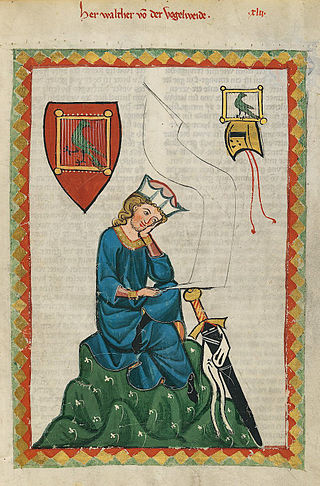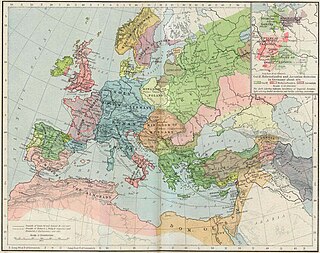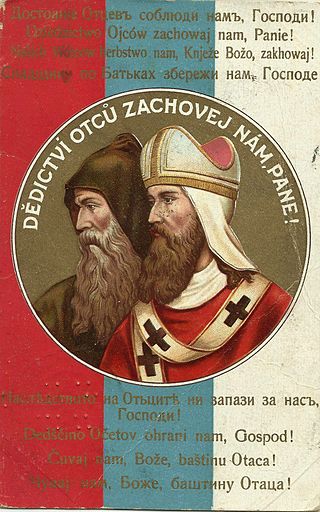This is a list of artists active within the Romanesque period of Western Art. As biographical information often is scarce about artists from this age, many are anonymous or known only by later notnames.
This is a list of artists active within the Romanesque period of Western Art. As biographical information often is scarce about artists from this age, many are anonymous or known only by later notnames.
The second millennium of the Anno Domini or Common Era was a millennium spanning the years 1001 to 2000. It began on 1 January 1001 (MI) and ended on 31 December 2000 (MM),.

The Codex Manesse is a Liederhandschrift, the single most comprehensive source of Middle High German Minnesang poetry, written and illustrated between c. 1304 when the main part was completed, and c. 1340 with the addenda.

Minnesang was a tradition of lyric- and song-writing in Germany and Austria that flourished in the Middle High German period. This period of medieval German literature began in the 12th century and continued into the 14th. People who wrote and performed Minnesang were known as Minnesänger, and a single song was called a Minnelied.

The chanson de geste is a medieval narrative, a type of epic poem that appears at the dawn of French literature. The earliest known poems of this genre date from the late 11th and early 12th centuries, shortly before the emergence of the lyric poetry of the troubadours and trouvères, and the earliest verse romances. They reached their highest point of acceptance in the period 1150–1250.

The High Middle Ages, or high medieval period, was the period of European history that lasted from AD 1000 to 1300. The High Middle Ages were preceded by the Early Middle Ages and were followed by the Late Middle Ages, which ended around AD 1500.

There were six major officers of the kingdom of Jerusalem: the constable, the marshal, the seneschal, the chamberlain, the butler and the chancellor. At certain times there were also bailiffs, viscounts and castellans.

Medieval French literature is, for the purpose of this article, Medieval literature written in Oïl languages during the period from the eleventh century to the end of the fifteenth century.

This article presents lists of the literary events and publications in the 12th century.

The Late Bronze Age collapse was a time of widespread societal collapse during the 12th century BC, between c. 1200 and 1150, and was associated with environmental change, mass migration and destruction of cities. The collapse affected a large area of the Eastern Mediterranean and the Near East, in particular Egypt, eastern Libya, the Balkans, the Aegean, Anatolia, and the Caucasus. It was sudden, violent, and culturally disruptive for many Bronze Age civilizations, and it brought a sharp economic decline to regional powers, notably ushering in the Greek Dark Ages.
The Prior of Loch Leven was the head of lands and of the community Augustinian canons of St Serf's Inch Priory, Loch Leven. There was a Scottish Céli Dé establishment there in the first half of the 12th century, allegedly found by Bruide, son of Dargart, King of the Picts (696–706). When the Augustinian priory was founded in 1150, the Scottish monks were absorbed into the established and those who refused to join were to be expelled. Not all of the priors are known. The most famous prior undoubtedly was the chronicler, Andrew de Wyntoun. Following more than four centuries of Augustinian monastic life and the resignation of the last prior, the Protestant king, James VI of Scotland, granted the priory to St Leonard's College, St Andrews.

Master Hugo was a Romanesque lay artist and the earliest recorded professional artist in England.
Máel Ísu, Maol Íosa or Máel Íosa, meaning devotee of Jesus, Latinised as Malise, may refer to:
Master Mateo was a sculptor and architect who worked in medieval Christian kingdoms of the Iberian Peninsula during the second half of the twelfth century. He is best known now for the Pórtico de la Gloria of the Cathedral of Santiago de Compostela. He was also responsible for the Stone choir of Master Mateo of the cathedral in 1200, later torn down in 1603.

The Slavs were Christianized in waves from the 7th to 12th century, though the process of replacing old Slavic religious practices began as early as the 6th century. Generally speaking, the monarchs of the South Slavs adopted Christianity in the 9th century, the East Slavs in the 10th, and the West Slavs between the 9th and 12th century. Saints Cyril and Methodius are attributed as "Apostles to the Slavs", having introduced the Byzantine-Slavic rite and Glagolitic alphabet, the oldest known Slavic alphabet and basis for the Early Cyrillic alphabet.
Bisantius, also spelled Byzantius, Byzantios, Bisanctus, Vyzantios or Visantius, was a masculine given name of Greek origin.